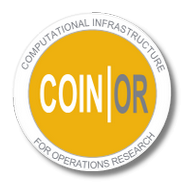- What software is available in the COIN-OR repository and how is it organized?
- What is the maturity level of a project?
- What is a stable version? What is a stable release?
- How do I obtain the source code for a COIN-OR project?
- How do I compile, link, and run the COIN-OR code?
- What licenses are COIN-OR projects distributed under?
- Who do I contact for COIN-OR related questions?
- Where do bugs get reported?
- How is the COIN-OR project managed?
- How can I help?
- Where does the name COIN-OR come from?
- Why is the web site url www.coin-or.org and not www.coin.org?
- I'd like to cite COIN-OR. I notice several publications, is there some standard paper that is typically cited?
- Level 0: A proposed project for which substantial development has yet to commence.
- Level 1: Projects that don’t work yet or don’t meet the requirements for becoming a Level 2 project.
- Level 2: Projects that build and do something useful.
- Level 3: Level 2 projects that also have substantial documentation, tutorials, examples codes, or other aids to enhance usability.
- Level 4: Level 3 projects that have versioning, a stable release (see below), and a substantial unit test.
- Level 5: Level 4 projects that distribute binaries or are packaged in some way.
A stable version means roughly that the feature set and API associated with that particular version are frozen, but the code may continue to evolve through the application of patches to fix bugs, the addition of documentation, etc. Such a stable version is identified by a two-digit version number (i.e., 5.1). Stable versions continue to evolve, but this evolution should generally consist of bug fixes and minor tweaking only—development of new features is reserved for future versions. The current stable version of a project can generally only be obtained using a SVN client (see below).
A stable release is a fixed snapshot of a stable version identified by a three-digit release number (i.e., 5.1.1). For information on obtaining releases, see the download page.
Please see the download page, as well as the COIN-OR User’s Guide.
Please see the COIN-OR User’s Guide.
Most current COIN-OR projects use the Eclipse Public License and this is the license we recommend. However, we accept projects licensed under any license officially approved by the Open Source Initiative. The author of the EPL is the Eclipse Foundation, and they have an EPL FAQ, based on their understanding of the EPL.
Go to the project’s Github site (see the projects page for a list). Create a new issue or start a discussion.
The COIN-OR project is managed by the COIN-OR Foundation, Inc., a non-profit educational foundation. More details are available on the COIN-OR Foundation page.
Glad you asked! Check out the contributing page for some ideas on getting started.
At its incarnation, COIN-OR was known as the “Common Optimization Interface for OR”. The name (but not the acronym) was later changed to better reflect that COIN-OR is intended to host all types of OR software, not just “optimization” software.
Because there is another open source project which uses the name COIN and someone else already had the url www.coin.org (but don’t go there; it’s been flagged for bad behaviour).
